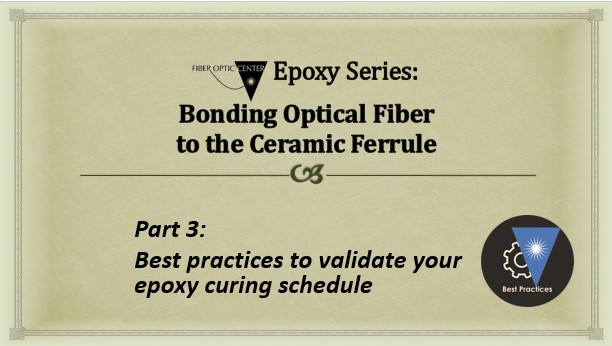Part 3: Bonding Optical Fiber to the Ceramic Ferrule
“How do I know what curing schedule I should use?”
This is a common question that fiber optic cable assembly houses ask – and it’s a particularly good question. Why? When our customers ask this question, it tells us they are focusing on a critical aspect of their bonding process. It tells us they have an appreciation for the vital role epoxy plays in the long-term reliability of their fiber optic cable assembly.
Keep in mind, all epoxy processes must be very well defined and controlled, as this is one process that cannot be validated by subsequent inspection or testing in the production line. In fiber optic cable assembly manufacturing, nearly every process can be double-checked farther down the line. For example, cable cut-lengths can be re-measured at the end of the line to ensure they meet requirements. The polishing process can be validated with a visual inspection and interferometer inspection. Improper crimping can be tested with pull-testing, and so forth. However, the effectiveness of how well the epoxy was applied or cured cannot be observed, inspected, or tested (without destroying the product). The epoxy is hidden within the ferrule, and there’s no way to observe if the proper amount of epoxy has been injected or whether the epoxy inside has been subjected to the proper curing temperature for the proper time.
Furthermore, the bonding process has arguably the biggest effect on the long-term reliability of cable assemblies. The consequences of deploying fiber optic cable assemblies that do not have properly prepared, dispensed, and cured epoxy can be catastrophic. That’s why you must have very tight controls in all aspects of the bonding process including epoxy mixing, application, curing, and testing.

Best practices to validate your curing schedule
Are you setting up a new bonding process and need to establish the curing schedule? Or is your production process set, but you are experiencing fiber movement and need to adjust curing temperature or time? Either way, follow this advice to validate your curing schedule:
- The starting point – Always start with the epoxy manufacturer’s recommendation for time and temperature. The optimum schedule may vary, depending on your application. Whatever curing schedule is selected, adhesive testing (as described in Telcordia GR-326, discussed below) will help to ensure the selected schedule is sufficient for your application.
- Characterize the oven ports – If you thermally cure epoxy, you must characterize the oven ports. Note that you are not measuring the ambient temperature of the port; instead, you are measuring the temperature of the epoxy inside a connector. Using a thermocouple probe potted in a ferrule is a great way to characterize oven ports, because this mimics the actual epoxy curing process for your product. For example, let’s say your curing schedule is 100 degrees C for 10 minutes. That doesn’t mean you simply put a connector into a 100-degree oven for 10 minutes. The epoxy’s temperature is influenced by the mass of the connector, so it may take 2 or 3 minutes for the epoxy’s internal temperature to reach 100 degrees C. Your total curing time may be 12 minutes, not 10. Read Part 2 of this article series for step-by-step instructions to characterize your oven ports.
- Build-in buffer time – While your curing time may be 12 minutes, you might adjust the timer to 15 minutes, giving you a 25% margin. You can’t really over-cure by time. If epoxy curing time is a bit longer, there’s no problem. However, if curing time is too short, there potentially can be problems with the bond and, therefore, with long-term product reliability. You always want to be conservative with epoxy due to the risk of shipping product with epoxy that isn’t properly cured. If your customer deploys cable assemblies with improperly cured epoxy, the cost to your company to replace product – after it has been installed in the field – can be catastrophic.
- Follow the Telcordia GR-326 standard – To validate your curing schedule, we strongly recommend incorporating adhesive testing into your bonding process, as described in Telcordia GR-326 (section 4.4.4.2). Adhesive testing is a simple, effective, and industry-accepted test to ensure you have a properly prepared and cured cable assembly. Simply put, in this test, a terminated ferrule is heated, and pressure is applied to the fiber to try to push it within the ferrule. If the fiber is not properly bonded to the ferrule, the fiber will move with this pressure. The amount of movement indicates how well the epoxy is bonding the glass fiber to the ceramic ferrule and, thus, whether the epoxy is properly cured. We highly recommend following this industry-standard – even if your customer’s specs don’t require it – due to the risk involved of shipping product that is not properly cured. Telcordia makes a clear effort to emphasize the importance of epoxy-related processes in GR-326. In addition to section 4.4.4.2 (adhesive testing), other valuable requirements are section 8.2.1.2.3 (qualification of epoxies) and R8-11 (this requires that samples of finished products are routinely subjected to simple tests, which give an indication of the effectiveness of the epoxy process).
- Conduct DSC testing – We recommend you also conduct a Differential Scanning Calorimetry (DSC) test on each incoming lot of epoxy. Briefly, this test measures the outgassing of the epoxy sample, offering insight about whether it has been properly cured. Successful DSC tests, in conjunction with Telcordia GR-326, would give you high confidence that the epoxy is good and your processes are suitable.
Conclusion: Long-term product reliability is largely about epoxy
Unfortunately, a vast majority of fiber optic cable assembly houses do not treat the bonding process with the time, attention, and respect it deserves. Epoxy has a major impact on product quality. In fact, we believe epoxy is the number-one determining factor affecting the long-term reliability of the product. Acknowledging the criticality of epoxy processes to product reliability – particularly considering that process failures are often impossible to detect without specialized or destructive testing – is essential for any fiber optic cable assembly house.
Bonding Optical Fiber to the Ceramic Ferrule SERIES:
- November 2017: Part 1: Best practices for epoxy preparation and dispensing
- December 2017: Part 2: Best practices to characterize oven ports used to thermally cure epoxy
- January 2018: Part 3: Best practices to validate your epoxy curing schedule
Click to learn more:
- Epoxy Bi-Pack News – and Usage Tips for Best Results
- Helpful Epoxy Tips (and a Few Tricks)
- Bond Line Thickness & More: Answers to Common Epoxy Questions
- Ideas to Adjust Your Epoxy Process: Recommendations to Reduce Waste (and Save Money) in Your Fiber Optic Cable Assembly Process
- Crystallization in Epoxies: Steps for You to Spot it – and Fix It.
- Crystallization in Epoxies: How to Identify and Reverse It
Additional resources from the FOC team include:
- View Epoxy Technical Solution Content
- View the Glossary, Acronyms, Military Specifications for Connectors
- Q&A Resource: email technical questions to AskFOC@focenter.com
- Bookmark the Adhesive/Epoxy Page and Contact Info




